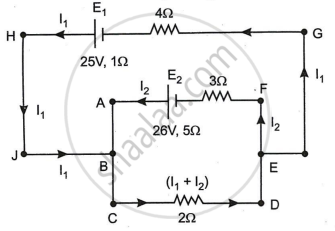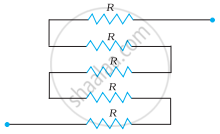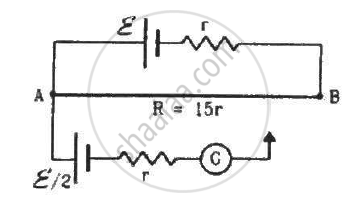Advertisements
Advertisements
प्रश्न
In the circuit shown in Figure below, E1 and E2 are batteries having emfs of 25V and 26V. They have an internal resistance of 1 Ω and 5 Ω respectively. Applying Kirchhoff’s laws of electrical networks, calculate the currents I1 and I2.

उत्तर
Applying Kirchhoff's voltage law to loop ABCDEF, we get
2(I1 + I2) + 3I2 - 26 + 5I2 = 0
or 2I1 + 2I2 + 3I2 + 5I2 = 26
or I1 + 5I2 = 13 ...(i)
Now, applying Kirchhoff’s voltage law to loop HJBCDEG.
2(I1 + I2) + 4I1 + I1 - 25 = 0
or 2I1 + 2I2 + 5I1 = 25
or 7I1 + 2I2 = 25 ...(ii)
Equation (i) × 2 - equation (ii) × 5
2I1 + 10I2 = 26
35I1 + 10I2 = 125
- - -
- 33I1 = - 99
I1 = 3
From equation (i)
3 + 5I2 = 13
or I2 = 2
Hence I1 = 3 A
I2 = 2 A.
APPEARS IN
संबंधित प्रश्न
Kirchhoff's voltage law and current law are respectively in accordance with the conservation of .................................. .
- charge and momentum
- charge and energy
- energy and charge
- energy and momentum
State the two Kirchhoff’s rules used in electric networks. How are there rules justified?
Given the resistances of 1 Ω, 2 Ω, 3 Ω, how will be combine them to get an equivalent resistance of 6 Ω?
Determine the equivalent resistance of networks shown in Fig.

Determine the equivalent resistance of networks shown in Fig.

State Kirchhoff's rules for an electric network. Using Kirchhoff's rules, obtain the balance condition in terms of the resistances of four arms of Wheatstone bridge.
Consider the potentiometer circuit as arranged in the figure. The potentiometer wire is 600 cm long. (a) At what distance from the point A should the jockey touch the wire to get zero deflection in the galvanometer? (b) If the jockey touches the wire at a distance of 560 cm from A, what will be the current in the galvanometer?

State the principle of potentiometer.
Explain the determination of unknown resistance using meter bridge.
What is the advantage of using thick metallic strips to join wires in a potentiometer?
